Analysis of Infection Control in Australian Hospitals Report
VerifiedAdded on 2022/11/25
|17
|3853
|341
Report
AI Summary
This report provides a comprehensive analysis of infection control strategies within the Australian healthcare system. It begins with an introduction to the importance of infection control, emphasizing its alignment with National Safety and Quality Health Service Standards. The report delves into background information, highlighting the increasing prevalence of infectious diseases and the necessity of effective intervention strategies. It discusses baseline measurements, including patient demographics, and the design of the study, which utilizes the IPCAF tool to assess the effectiveness of infection control measures. The report details specific strategies, such as the PDSA cycle, focusing on interventions related to injection control, hand hygiene, and other infection prevention methods. It evaluates the strengths and limitations of the chosen methodologies, including the IPCAF tool and the PDSA cycle, and concludes with an overview of ethical considerations and recommendations for future research. This report is designed to provide insights into the critical aspects of infection control, offering valuable information for healthcare professionals and students alike.
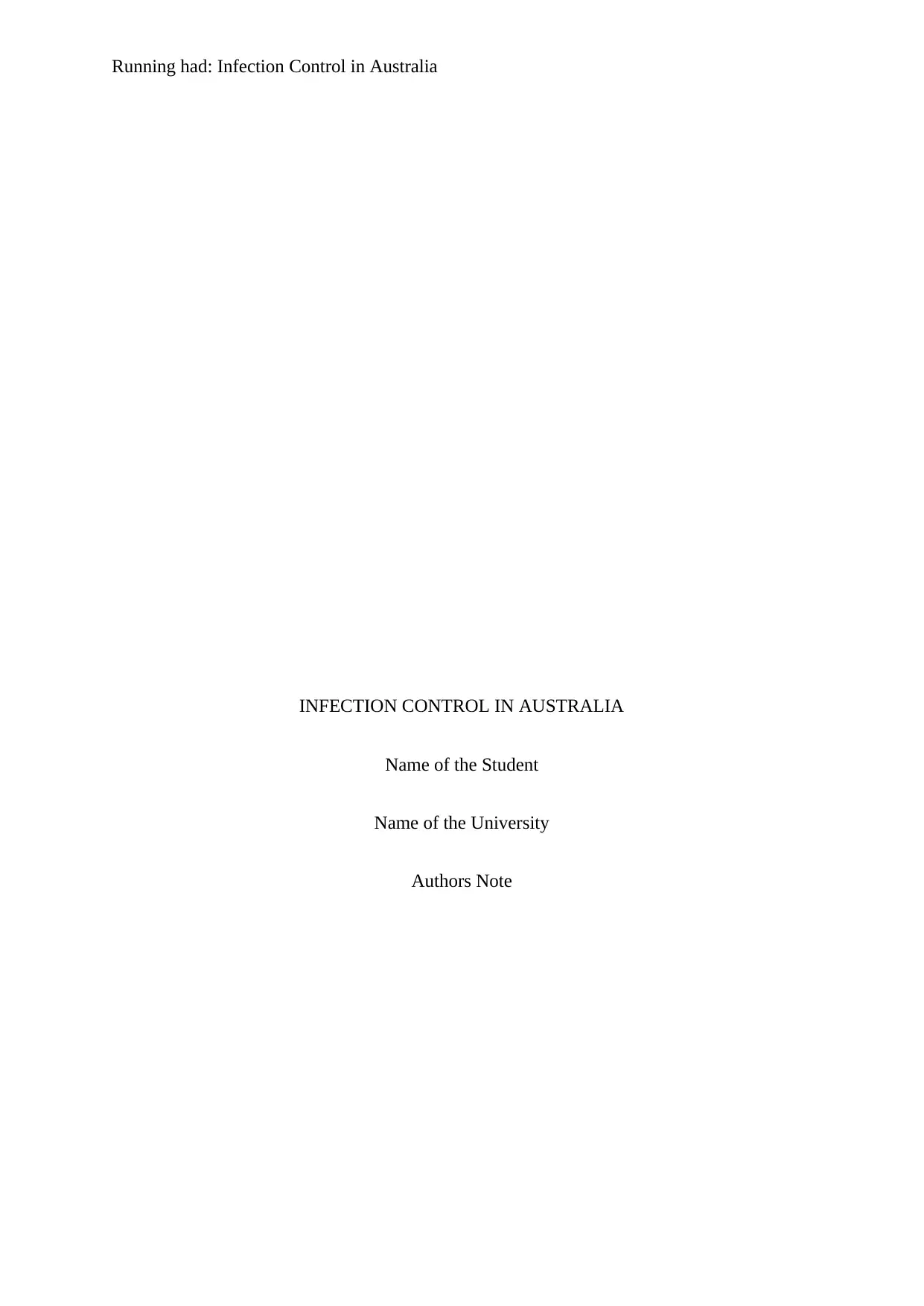
Running had: Infection Control in Australia
INFECTION CONTROL IN AUSTRALIA
Name of the Student
Name of the University
Authors Note
INFECTION CONTROL IN AUSTRALIA
Name of the Student
Name of the University
Authors Note
Paraphrase This Document
Need a fresh take? Get an instant paraphrase of this document with our AI Paraphraser
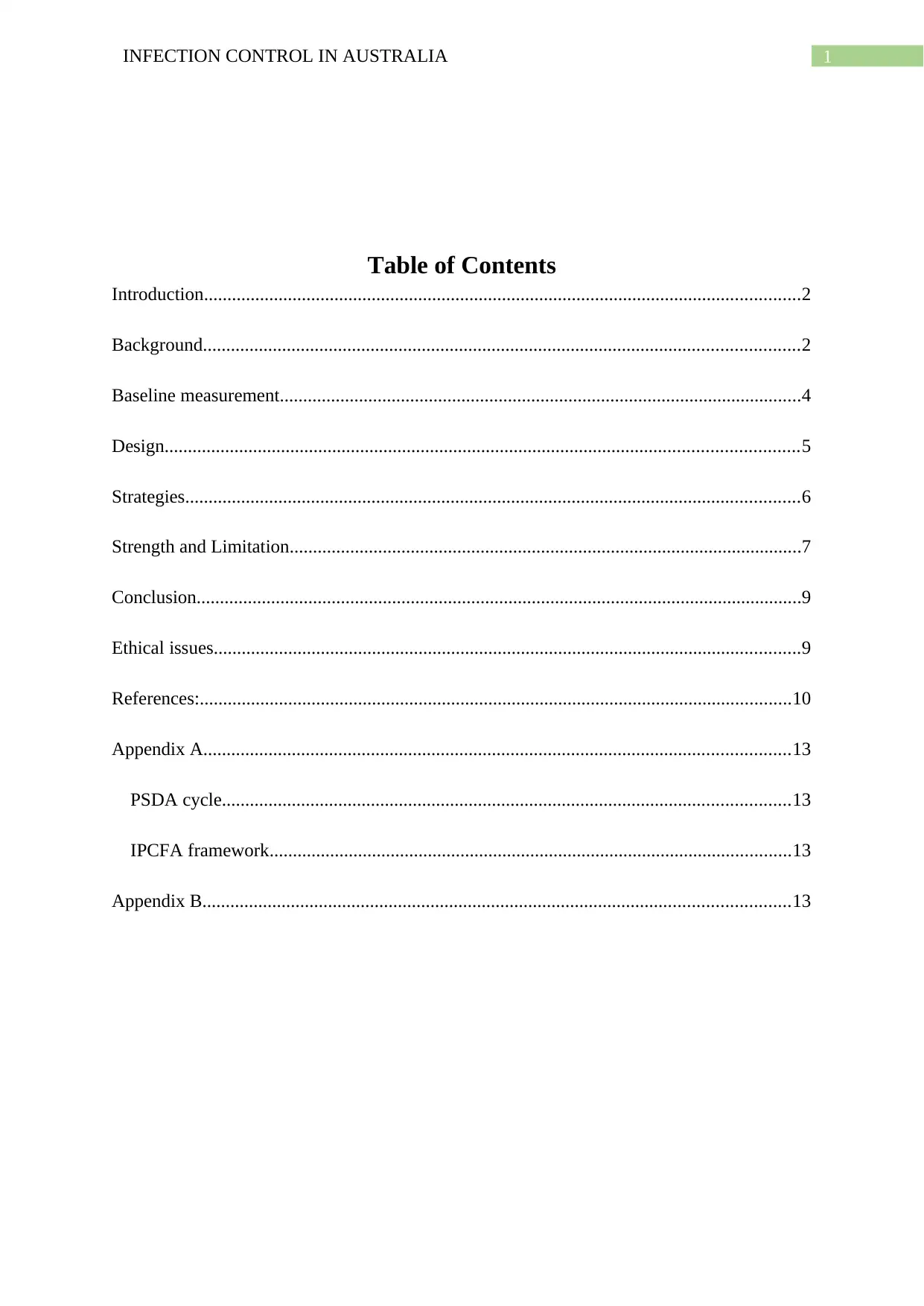
1INFECTION CONTROL IN AUSTRALIA
Table of Contents
Introduction................................................................................................................................2
Background................................................................................................................................2
Baseline measurement................................................................................................................4
Design........................................................................................................................................5
Strategies....................................................................................................................................6
Strength and Limitation..............................................................................................................7
Conclusion..................................................................................................................................9
Ethical issues..............................................................................................................................9
References:...............................................................................................................................10
Appendix A..............................................................................................................................13
PSDA cycle..........................................................................................................................13
IPCFA framework................................................................................................................13
Appendix B..............................................................................................................................13
Table of Contents
Introduction................................................................................................................................2
Background................................................................................................................................2
Baseline measurement................................................................................................................4
Design........................................................................................................................................5
Strategies....................................................................................................................................6
Strength and Limitation..............................................................................................................7
Conclusion..................................................................................................................................9
Ethical issues..............................................................................................................................9
References:...............................................................................................................................10
Appendix A..............................................................................................................................13
PSDA cycle..........................................................................................................................13
IPCFA framework................................................................................................................13
Appendix B..............................................................................................................................13
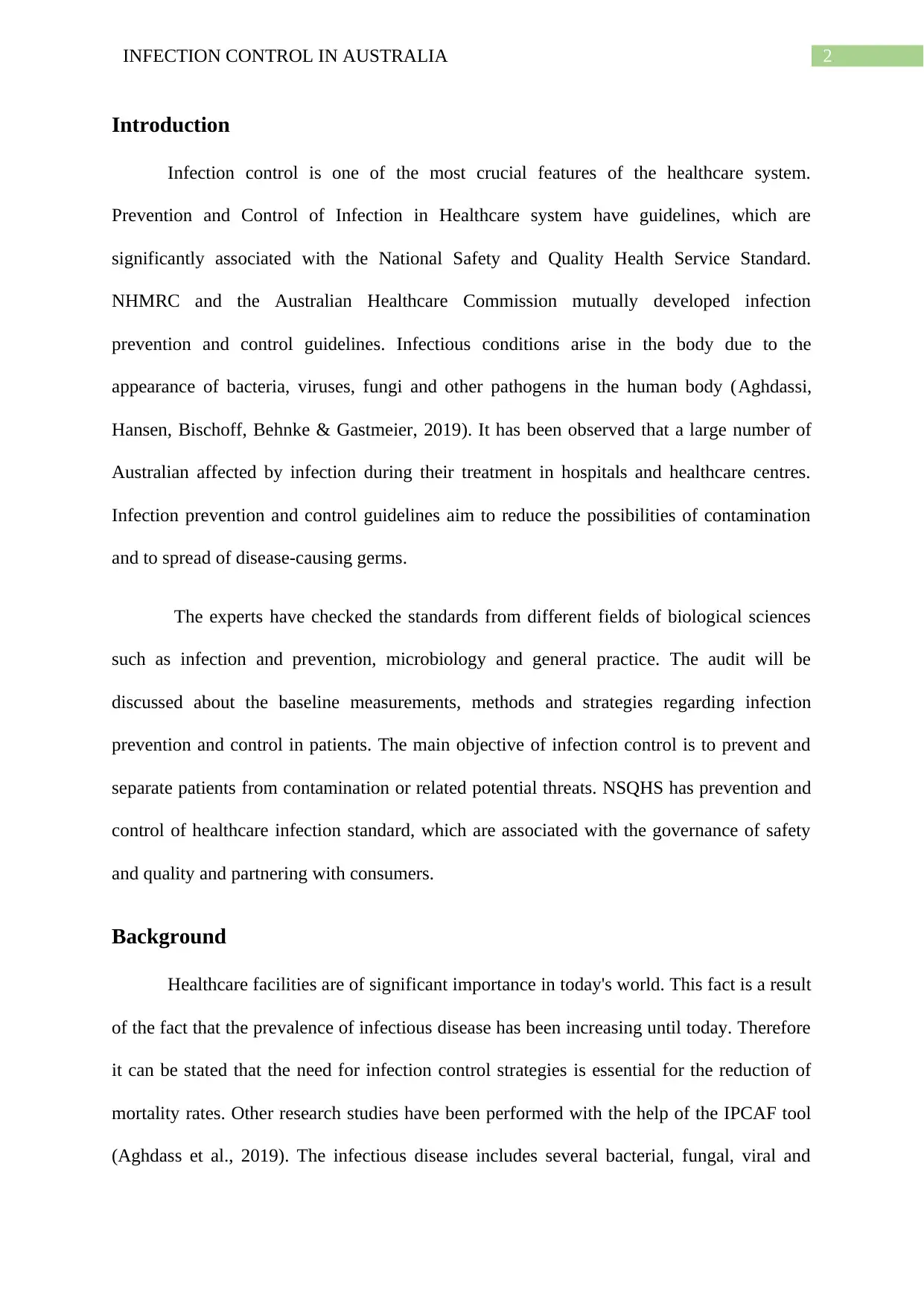
2INFECTION CONTROL IN AUSTRALIA
Introduction
Infection control is one of the most crucial features of the healthcare system.
Prevention and Control of Infection in Healthcare system have guidelines, which are
significantly associated with the National Safety and Quality Health Service Standard.
NHMRC and the Australian Healthcare Commission mutually developed infection
prevention and control guidelines. Infectious conditions arise in the body due to the
appearance of bacteria, viruses, fungi and other pathogens in the human body (Aghdassi,
Hansen, Bischoff, Behnke & Gastmeier, 2019). It has been observed that a large number of
Australian affected by infection during their treatment in hospitals and healthcare centres.
Infection prevention and control guidelines aim to reduce the possibilities of contamination
and to spread of disease-causing germs.
The experts have checked the standards from different fields of biological sciences
such as infection and prevention, microbiology and general practice. The audit will be
discussed about the baseline measurements, methods and strategies regarding infection
prevention and control in patients. The main objective of infection control is to prevent and
separate patients from contamination or related potential threats. NSQHS has prevention and
control of healthcare infection standard, which are associated with the governance of safety
and quality and partnering with consumers.
Background
Healthcare facilities are of significant importance in today's world. This fact is a result
of the fact that the prevalence of infectious disease has been increasing until today. Therefore
it can be stated that the need for infection control strategies is essential for the reduction of
mortality rates. Other research studies have been performed with the help of the IPCAF tool
(Aghdass et al., 2019). The infectious disease includes several bacterial, fungal, viral and
Introduction
Infection control is one of the most crucial features of the healthcare system.
Prevention and Control of Infection in Healthcare system have guidelines, which are
significantly associated with the National Safety and Quality Health Service Standard.
NHMRC and the Australian Healthcare Commission mutually developed infection
prevention and control guidelines. Infectious conditions arise in the body due to the
appearance of bacteria, viruses, fungi and other pathogens in the human body (Aghdassi,
Hansen, Bischoff, Behnke & Gastmeier, 2019). It has been observed that a large number of
Australian affected by infection during their treatment in hospitals and healthcare centres.
Infection prevention and control guidelines aim to reduce the possibilities of contamination
and to spread of disease-causing germs.
The experts have checked the standards from different fields of biological sciences
such as infection and prevention, microbiology and general practice. The audit will be
discussed about the baseline measurements, methods and strategies regarding infection
prevention and control in patients. The main objective of infection control is to prevent and
separate patients from contamination or related potential threats. NSQHS has prevention and
control of healthcare infection standard, which are associated with the governance of safety
and quality and partnering with consumers.
Background
Healthcare facilities are of significant importance in today's world. This fact is a result
of the fact that the prevalence of infectious disease has been increasing until today. Therefore
it can be stated that the need for infection control strategies is essential for the reduction of
mortality rates. Other research studies have been performed with the help of the IPCAF tool
(Aghdass et al., 2019). The infectious disease includes several bacterial, fungal, viral and
⊘ This is a preview!⊘
Do you want full access?
Subscribe today to unlock all pages.

Trusted by 1+ million students worldwide
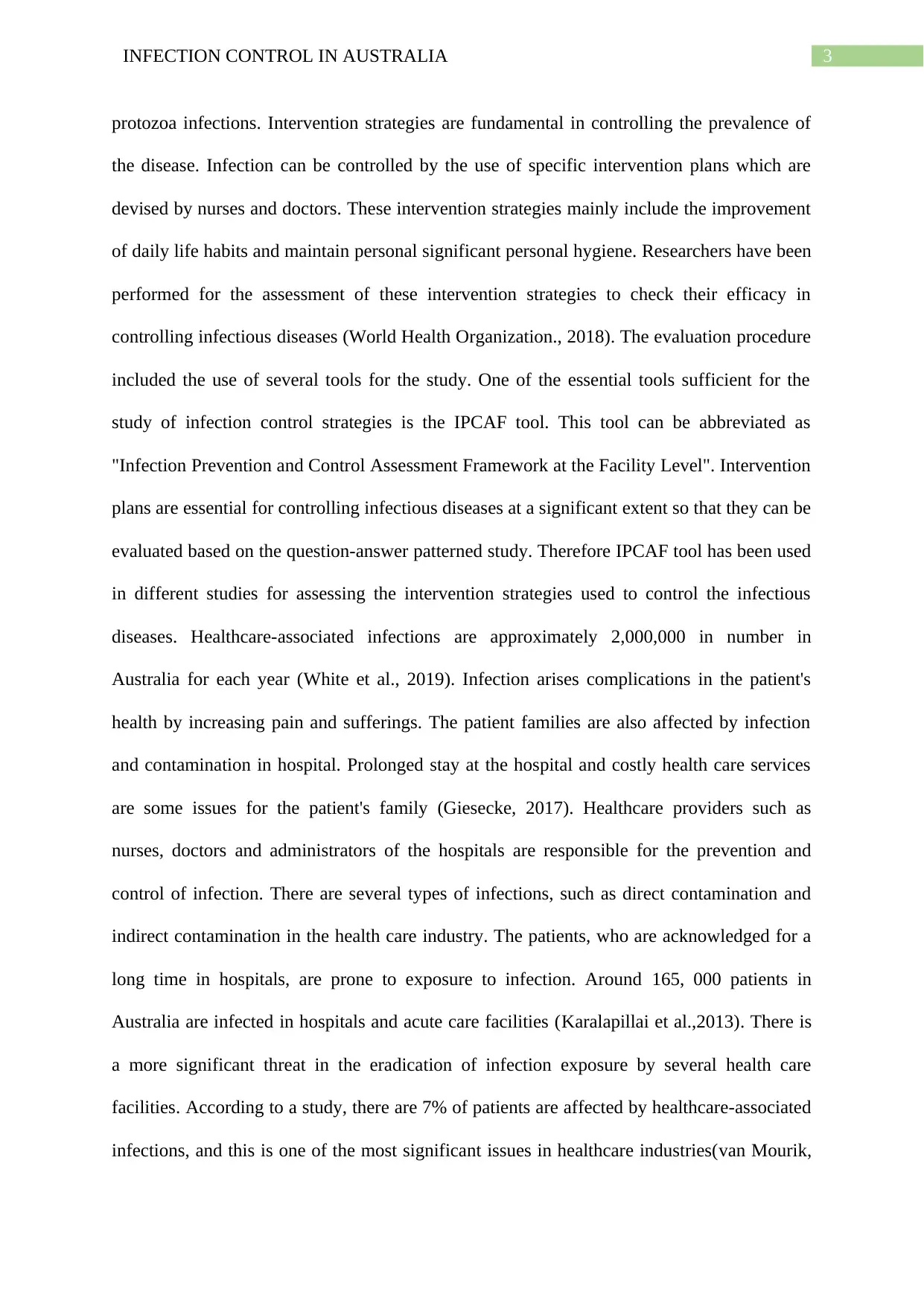
3INFECTION CONTROL IN AUSTRALIA
protozoa infections. Intervention strategies are fundamental in controlling the prevalence of
the disease. Infection can be controlled by the use of specific intervention plans which are
devised by nurses and doctors. These intervention strategies mainly include the improvement
of daily life habits and maintain personal significant personal hygiene. Researchers have been
performed for the assessment of these intervention strategies to check their efficacy in
controlling infectious diseases (World Health Organization., 2018). The evaluation procedure
included the use of several tools for the study. One of the essential tools sufficient for the
study of infection control strategies is the IPCAF tool. This tool can be abbreviated as
"Infection Prevention and Control Assessment Framework at the Facility Level". Intervention
plans are essential for controlling infectious diseases at a significant extent so that they can be
evaluated based on the question-answer patterned study. Therefore IPCAF tool has been used
in different studies for assessing the intervention strategies used to control the infectious
diseases. Healthcare-associated infections are approximately 2,000,000 in number in
Australia for each year (White et al., 2019). Infection arises complications in the patient's
health by increasing pain and sufferings. The patient families are also affected by infection
and contamination in hospital. Prolonged stay at the hospital and costly health care services
are some issues for the patient's family (Giesecke, 2017). Healthcare providers such as
nurses, doctors and administrators of the hospitals are responsible for the prevention and
control of infection. There are several types of infections, such as direct contamination and
indirect contamination in the health care industry. The patients, who are acknowledged for a
long time in hospitals, are prone to exposure to infection. Around 165, 000 patients in
Australia are infected in hospitals and acute care facilities (Karalapillai et al.,2013). There is
a more significant threat in the eradication of infection exposure by several health care
facilities. According to a study, there are 7% of patients are affected by healthcare-associated
infections, and this is one of the most significant issues in healthcare industries(van Mourik,
protozoa infections. Intervention strategies are fundamental in controlling the prevalence of
the disease. Infection can be controlled by the use of specific intervention plans which are
devised by nurses and doctors. These intervention strategies mainly include the improvement
of daily life habits and maintain personal significant personal hygiene. Researchers have been
performed for the assessment of these intervention strategies to check their efficacy in
controlling infectious diseases (World Health Organization., 2018). The evaluation procedure
included the use of several tools for the study. One of the essential tools sufficient for the
study of infection control strategies is the IPCAF tool. This tool can be abbreviated as
"Infection Prevention and Control Assessment Framework at the Facility Level". Intervention
plans are essential for controlling infectious diseases at a significant extent so that they can be
evaluated based on the question-answer patterned study. Therefore IPCAF tool has been used
in different studies for assessing the intervention strategies used to control the infectious
diseases. Healthcare-associated infections are approximately 2,000,000 in number in
Australia for each year (White et al., 2019). Infection arises complications in the patient's
health by increasing pain and sufferings. The patient families are also affected by infection
and contamination in hospital. Prolonged stay at the hospital and costly health care services
are some issues for the patient's family (Giesecke, 2017). Healthcare providers such as
nurses, doctors and administrators of the hospitals are responsible for the prevention and
control of infection. There are several types of infections, such as direct contamination and
indirect contamination in the health care industry. The patients, who are acknowledged for a
long time in hospitals, are prone to exposure to infection. Around 165, 000 patients in
Australia are infected in hospitals and acute care facilities (Karalapillai et al.,2013). There is
a more significant threat in the eradication of infection exposure by several health care
facilities. According to a study, there are 7% of patients are affected by healthcare-associated
infections, and this is one of the most significant issues in healthcare industries(van Mourik,
Paraphrase This Document
Need a fresh take? Get an instant paraphrase of this document with our AI Paraphraser
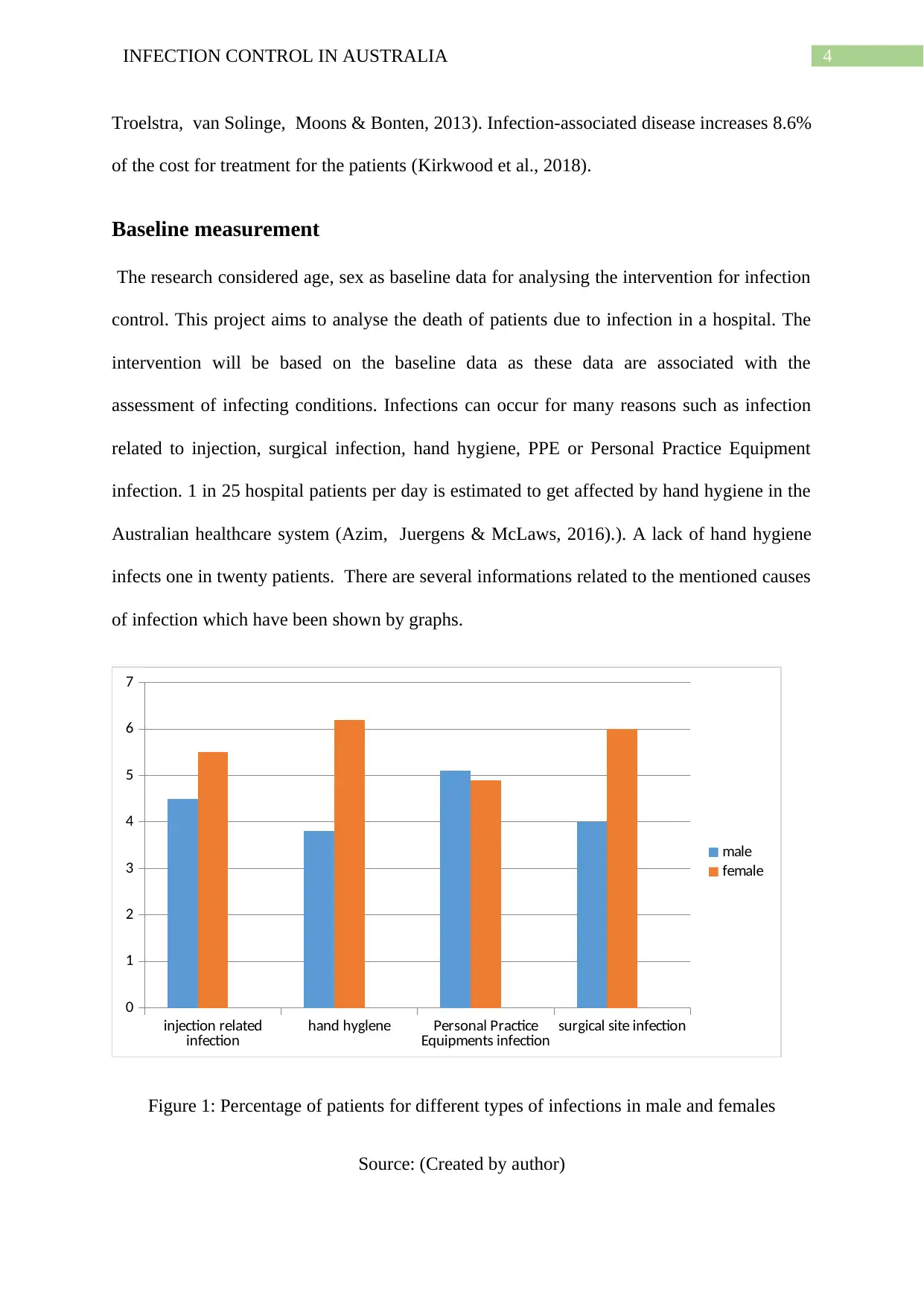
4INFECTION CONTROL IN AUSTRALIA
Troelstra, van Solinge, Moons & Bonten, 2013). Infection-associated disease increases 8.6%
of the cost for treatment for the patients (Kirkwood et al., 2018).
Baseline measurement
The research considered age, sex as baseline data for analysing the intervention for infection
control. This project aims to analyse the death of patients due to infection in a hospital. The
intervention will be based on the baseline data as these data are associated with the
assessment of infecting conditions. Infections can occur for many reasons such as infection
related to injection, surgical infection, hand hygiene, PPE or Personal Practice Equipment
infection. 1 in 25 hospital patients per day is estimated to get affected by hand hygiene in the
Australian healthcare system (Azim, Juergens & McLaws, 2016).). A lack of hand hygiene
infects one in twenty patients. There are several informations related to the mentioned causes
of infection which have been shown by graphs.
injection related
infection hand hyglene Personal Practice
Equipments infection surgical site infection
0
1
2
3
4
5
6
7
male
female
Figure 1: Percentage of patients for different types of infections in male and females
Source: (Created by author)
Troelstra, van Solinge, Moons & Bonten, 2013). Infection-associated disease increases 8.6%
of the cost for treatment for the patients (Kirkwood et al., 2018).
Baseline measurement
The research considered age, sex as baseline data for analysing the intervention for infection
control. This project aims to analyse the death of patients due to infection in a hospital. The
intervention will be based on the baseline data as these data are associated with the
assessment of infecting conditions. Infections can occur for many reasons such as infection
related to injection, surgical infection, hand hygiene, PPE or Personal Practice Equipment
infection. 1 in 25 hospital patients per day is estimated to get affected by hand hygiene in the
Australian healthcare system (Azim, Juergens & McLaws, 2016).). A lack of hand hygiene
infects one in twenty patients. There are several informations related to the mentioned causes
of infection which have been shown by graphs.
injection related
infection hand hyglene Personal Practice
Equipments infection surgical site infection
0
1
2
3
4
5
6
7
male
female
Figure 1: Percentage of patients for different types of infections in male and females
Source: (Created by author)
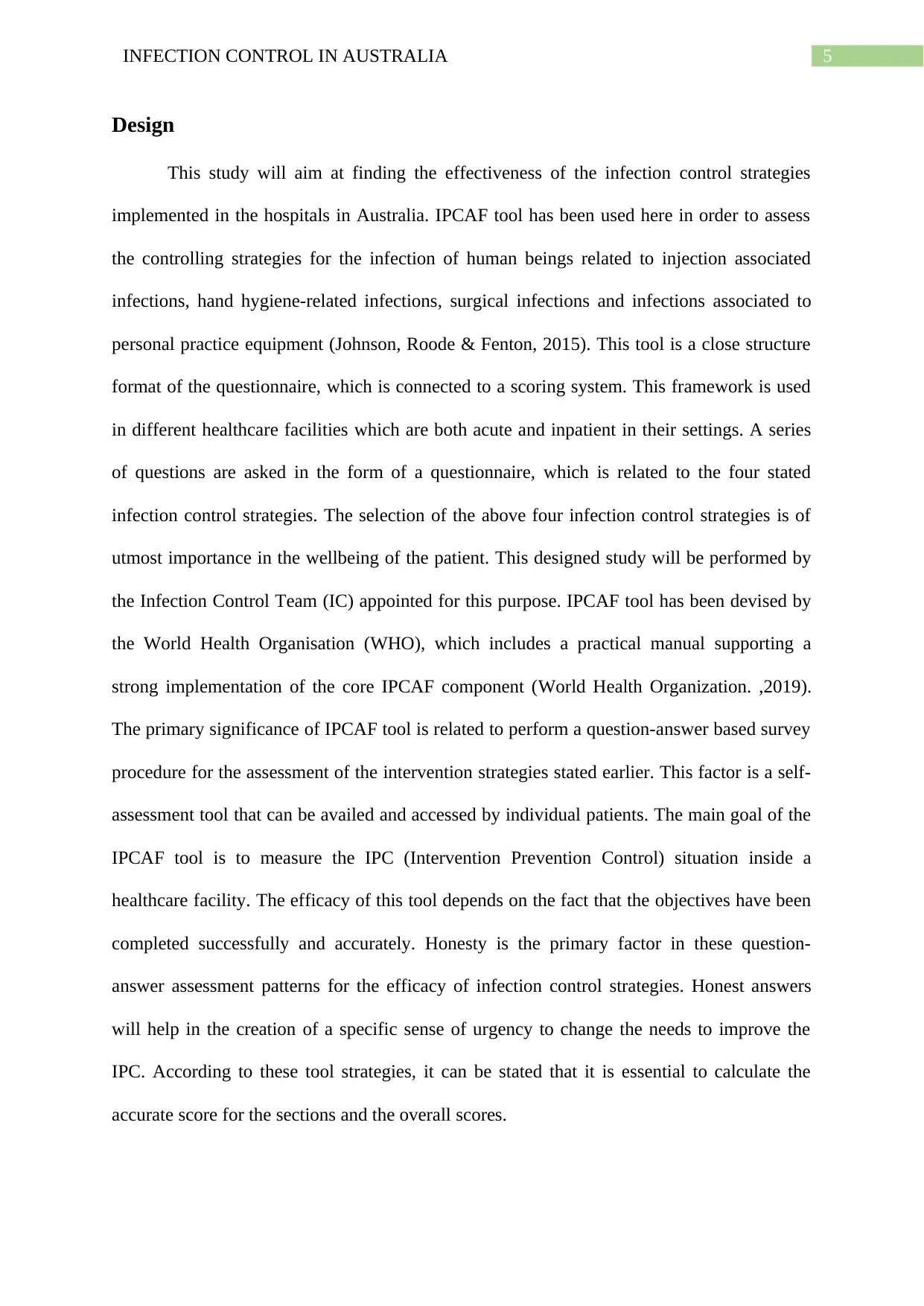
5INFECTION CONTROL IN AUSTRALIA
Design
This study will aim at finding the effectiveness of the infection control strategies
implemented in the hospitals in Australia. IPCAF tool has been used here in order to assess
the controlling strategies for the infection of human beings related to injection associated
infections, hand hygiene-related infections, surgical infections and infections associated to
personal practice equipment (Johnson, Roode & Fenton, 2015). This tool is a close structure
format of the questionnaire, which is connected to a scoring system. This framework is used
in different healthcare facilities which are both acute and inpatient in their settings. A series
of questions are asked in the form of a questionnaire, which is related to the four stated
infection control strategies. The selection of the above four infection control strategies is of
utmost importance in the wellbeing of the patient. This designed study will be performed by
the Infection Control Team (IC) appointed for this purpose. IPCAF tool has been devised by
the World Health Organisation (WHO), which includes a practical manual supporting a
strong implementation of the core IPCAF component (World Health Organization. ,2019).
The primary significance of IPCAF tool is related to perform a question-answer based survey
procedure for the assessment of the intervention strategies stated earlier. This factor is a self-
assessment tool that can be availed and accessed by individual patients. The main goal of the
IPCAF tool is to measure the IPC (Intervention Prevention Control) situation inside a
healthcare facility. The efficacy of this tool depends on the fact that the objectives have been
completed successfully and accurately. Honesty is the primary factor in these question-
answer assessment patterns for the efficacy of infection control strategies. Honest answers
will help in the creation of a specific sense of urgency to change the needs to improve the
IPC. According to these tool strategies, it can be stated that it is essential to calculate the
accurate score for the sections and the overall scores.
Design
This study will aim at finding the effectiveness of the infection control strategies
implemented in the hospitals in Australia. IPCAF tool has been used here in order to assess
the controlling strategies for the infection of human beings related to injection associated
infections, hand hygiene-related infections, surgical infections and infections associated to
personal practice equipment (Johnson, Roode & Fenton, 2015). This tool is a close structure
format of the questionnaire, which is connected to a scoring system. This framework is used
in different healthcare facilities which are both acute and inpatient in their settings. A series
of questions are asked in the form of a questionnaire, which is related to the four stated
infection control strategies. The selection of the above four infection control strategies is of
utmost importance in the wellbeing of the patient. This designed study will be performed by
the Infection Control Team (IC) appointed for this purpose. IPCAF tool has been devised by
the World Health Organisation (WHO), which includes a practical manual supporting a
strong implementation of the core IPCAF component (World Health Organization. ,2019).
The primary significance of IPCAF tool is related to perform a question-answer based survey
procedure for the assessment of the intervention strategies stated earlier. This factor is a self-
assessment tool that can be availed and accessed by individual patients. The main goal of the
IPCAF tool is to measure the IPC (Intervention Prevention Control) situation inside a
healthcare facility. The efficacy of this tool depends on the fact that the objectives have been
completed successfully and accurately. Honesty is the primary factor in these question-
answer assessment patterns for the efficacy of infection control strategies. Honest answers
will help in the creation of a specific sense of urgency to change the needs to improve the
IPC. According to these tool strategies, it can be stated that it is essential to calculate the
accurate score for the sections and the overall scores.
⊘ This is a preview!⊘
Do you want full access?
Subscribe today to unlock all pages.

Trusted by 1+ million students worldwide
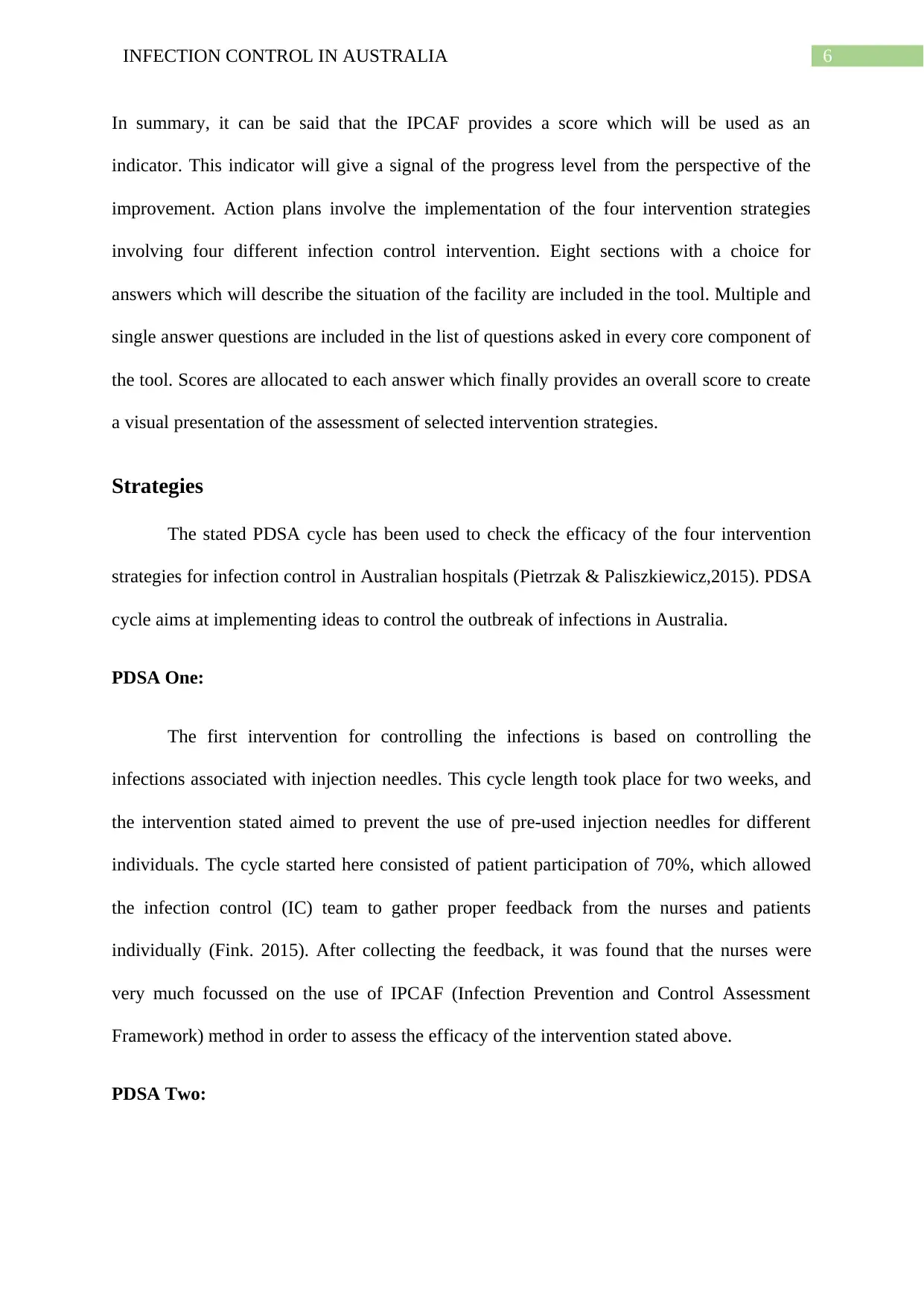
6INFECTION CONTROL IN AUSTRALIA
In summary, it can be said that the IPCAF provides a score which will be used as an
indicator. This indicator will give a signal of the progress level from the perspective of the
improvement. Action plans involve the implementation of the four intervention strategies
involving four different infection control intervention. Eight sections with a choice for
answers which will describe the situation of the facility are included in the tool. Multiple and
single answer questions are included in the list of questions asked in every core component of
the tool. Scores are allocated to each answer which finally provides an overall score to create
a visual presentation of the assessment of selected intervention strategies.
Strategies
The stated PDSA cycle has been used to check the efficacy of the four intervention
strategies for infection control in Australian hospitals (Pietrzak & Paliszkiewicz,2015). PDSA
cycle aims at implementing ideas to control the outbreak of infections in Australia.
PDSA One:
The first intervention for controlling the infections is based on controlling the
infections associated with injection needles. This cycle length took place for two weeks, and
the intervention stated aimed to prevent the use of pre-used injection needles for different
individuals. The cycle started here consisted of patient participation of 70%, which allowed
the infection control (IC) team to gather proper feedback from the nurses and patients
individually (Fink. 2015). After collecting the feedback, it was found that the nurses were
very much focussed on the use of IPCAF (Infection Prevention and Control Assessment
Framework) method in order to assess the efficacy of the intervention stated above.
PDSA Two:
In summary, it can be said that the IPCAF provides a score which will be used as an
indicator. This indicator will give a signal of the progress level from the perspective of the
improvement. Action plans involve the implementation of the four intervention strategies
involving four different infection control intervention. Eight sections with a choice for
answers which will describe the situation of the facility are included in the tool. Multiple and
single answer questions are included in the list of questions asked in every core component of
the tool. Scores are allocated to each answer which finally provides an overall score to create
a visual presentation of the assessment of selected intervention strategies.
Strategies
The stated PDSA cycle has been used to check the efficacy of the four intervention
strategies for infection control in Australian hospitals (Pietrzak & Paliszkiewicz,2015). PDSA
cycle aims at implementing ideas to control the outbreak of infections in Australia.
PDSA One:
The first intervention for controlling the infections is based on controlling the
infections associated with injection needles. This cycle length took place for two weeks, and
the intervention stated aimed to prevent the use of pre-used injection needles for different
individuals. The cycle started here consisted of patient participation of 70%, which allowed
the infection control (IC) team to gather proper feedback from the nurses and patients
individually (Fink. 2015). After collecting the feedback, it was found that the nurses were
very much focussed on the use of IPCAF (Infection Prevention and Control Assessment
Framework) method in order to assess the efficacy of the intervention stated above.
PDSA Two:
Paraphrase This Document
Need a fresh take? Get an instant paraphrase of this document with our AI Paraphraser
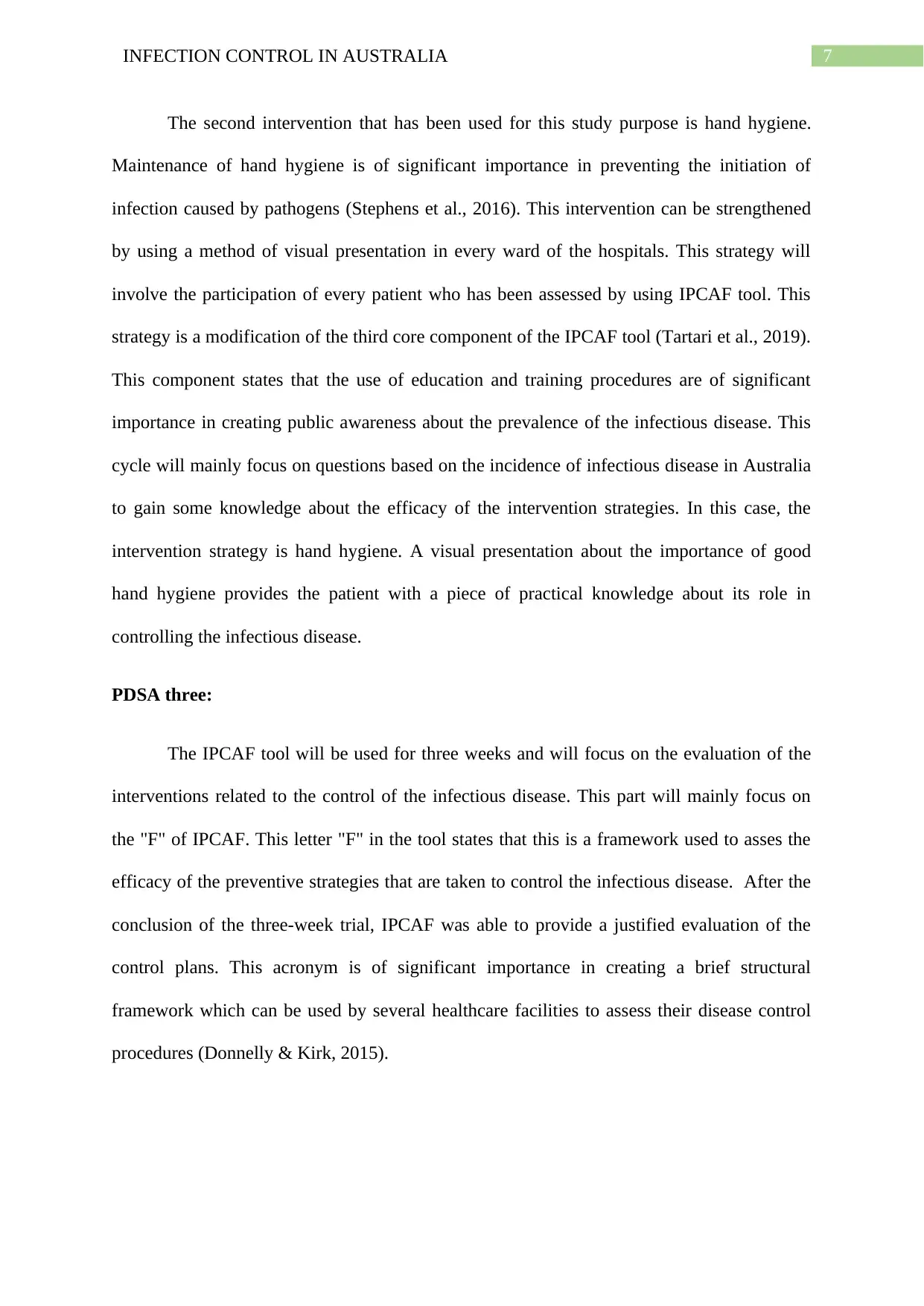
7INFECTION CONTROL IN AUSTRALIA
The second intervention that has been used for this study purpose is hand hygiene.
Maintenance of hand hygiene is of significant importance in preventing the initiation of
infection caused by pathogens (Stephens et al., 2016). This intervention can be strengthened
by using a method of visual presentation in every ward of the hospitals. This strategy will
involve the participation of every patient who has been assessed by using IPCAF tool. This
strategy is a modification of the third core component of the IPCAF tool (Tartari et al., 2019).
This component states that the use of education and training procedures are of significant
importance in creating public awareness about the prevalence of the infectious disease. This
cycle will mainly focus on questions based on the incidence of infectious disease in Australia
to gain some knowledge about the efficacy of the intervention strategies. In this case, the
intervention strategy is hand hygiene. A visual presentation about the importance of good
hand hygiene provides the patient with a piece of practical knowledge about its role in
controlling the infectious disease.
PDSA three:
The IPCAF tool will be used for three weeks and will focus on the evaluation of the
interventions related to the control of the infectious disease. This part will mainly focus on
the "F" of IPCAF. This letter "F" in the tool states that this is a framework used to asses the
efficacy of the preventive strategies that are taken to control the infectious disease. After the
conclusion of the three-week trial, IPCAF was able to provide a justified evaluation of the
control plans. This acronym is of significant importance in creating a brief structural
framework which can be used by several healthcare facilities to assess their disease control
procedures (Donnelly & Kirk, 2015).
The second intervention that has been used for this study purpose is hand hygiene.
Maintenance of hand hygiene is of significant importance in preventing the initiation of
infection caused by pathogens (Stephens et al., 2016). This intervention can be strengthened
by using a method of visual presentation in every ward of the hospitals. This strategy will
involve the participation of every patient who has been assessed by using IPCAF tool. This
strategy is a modification of the third core component of the IPCAF tool (Tartari et al., 2019).
This component states that the use of education and training procedures are of significant
importance in creating public awareness about the prevalence of the infectious disease. This
cycle will mainly focus on questions based on the incidence of infectious disease in Australia
to gain some knowledge about the efficacy of the intervention strategies. In this case, the
intervention strategy is hand hygiene. A visual presentation about the importance of good
hand hygiene provides the patient with a piece of practical knowledge about its role in
controlling the infectious disease.
PDSA three:
The IPCAF tool will be used for three weeks and will focus on the evaluation of the
interventions related to the control of the infectious disease. This part will mainly focus on
the "F" of IPCAF. This letter "F" in the tool states that this is a framework used to asses the
efficacy of the preventive strategies that are taken to control the infectious disease. After the
conclusion of the three-week trial, IPCAF was able to provide a justified evaluation of the
control plans. This acronym is of significant importance in creating a brief structural
framework which can be used by several healthcare facilities to assess their disease control
procedures (Donnelly & Kirk, 2015).
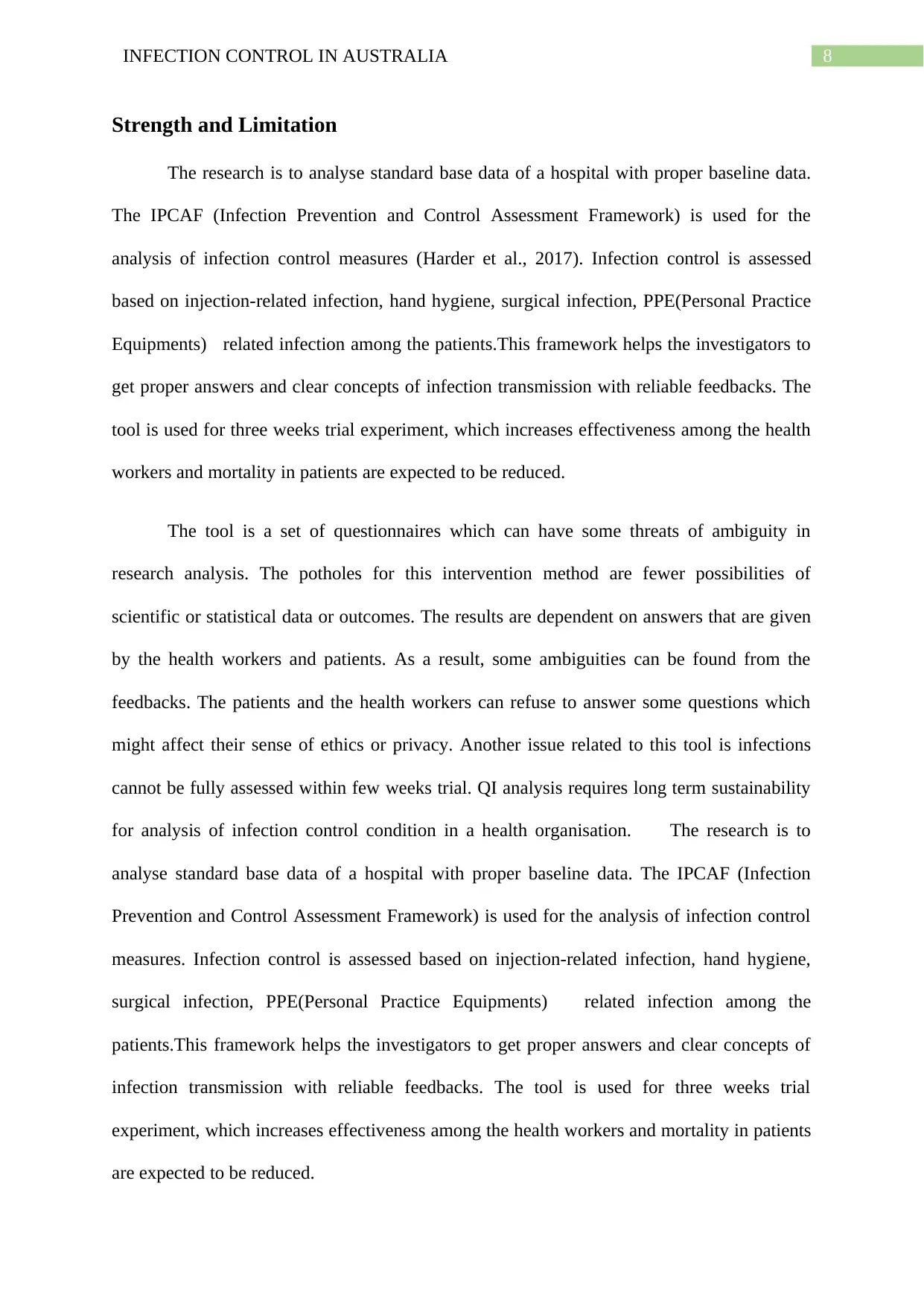
8INFECTION CONTROL IN AUSTRALIA
Strength and Limitation
The research is to analyse standard base data of a hospital with proper baseline data.
The IPCAF (Infection Prevention and Control Assessment Framework) is used for the
analysis of infection control measures (Harder et al., 2017). Infection control is assessed
based on injection-related infection, hand hygiene, surgical infection, PPE(Personal Practice
Equipments) related infection among the patients.This framework helps the investigators to
get proper answers and clear concepts of infection transmission with reliable feedbacks. The
tool is used for three weeks trial experiment, which increases effectiveness among the health
workers and mortality in patients are expected to be reduced.
The tool is a set of questionnaires which can have some threats of ambiguity in
research analysis. The potholes for this intervention method are fewer possibilities of
scientific or statistical data or outcomes. The results are dependent on answers that are given
by the health workers and patients. As a result, some ambiguities can be found from the
feedbacks. The patients and the health workers can refuse to answer some questions which
might affect their sense of ethics or privacy. Another issue related to this tool is infections
cannot be fully assessed within few weeks trial. QI analysis requires long term sustainability
for analysis of infection control condition in a health organisation. The research is to
analyse standard base data of a hospital with proper baseline data. The IPCAF (Infection
Prevention and Control Assessment Framework) is used for the analysis of infection control
measures. Infection control is assessed based on injection-related infection, hand hygiene,
surgical infection, PPE(Personal Practice Equipments) related infection among the
patients.This framework helps the investigators to get proper answers and clear concepts of
infection transmission with reliable feedbacks. The tool is used for three weeks trial
experiment, which increases effectiveness among the health workers and mortality in patients
are expected to be reduced.
Strength and Limitation
The research is to analyse standard base data of a hospital with proper baseline data.
The IPCAF (Infection Prevention and Control Assessment Framework) is used for the
analysis of infection control measures (Harder et al., 2017). Infection control is assessed
based on injection-related infection, hand hygiene, surgical infection, PPE(Personal Practice
Equipments) related infection among the patients.This framework helps the investigators to
get proper answers and clear concepts of infection transmission with reliable feedbacks. The
tool is used for three weeks trial experiment, which increases effectiveness among the health
workers and mortality in patients are expected to be reduced.
The tool is a set of questionnaires which can have some threats of ambiguity in
research analysis. The potholes for this intervention method are fewer possibilities of
scientific or statistical data or outcomes. The results are dependent on answers that are given
by the health workers and patients. As a result, some ambiguities can be found from the
feedbacks. The patients and the health workers can refuse to answer some questions which
might affect their sense of ethics or privacy. Another issue related to this tool is infections
cannot be fully assessed within few weeks trial. QI analysis requires long term sustainability
for analysis of infection control condition in a health organisation. The research is to
analyse standard base data of a hospital with proper baseline data. The IPCAF (Infection
Prevention and Control Assessment Framework) is used for the analysis of infection control
measures. Infection control is assessed based on injection-related infection, hand hygiene,
surgical infection, PPE(Personal Practice Equipments) related infection among the
patients.This framework helps the investigators to get proper answers and clear concepts of
infection transmission with reliable feedbacks. The tool is used for three weeks trial
experiment, which increases effectiveness among the health workers and mortality in patients
are expected to be reduced.
⊘ This is a preview!⊘
Do you want full access?
Subscribe today to unlock all pages.

Trusted by 1+ million students worldwide
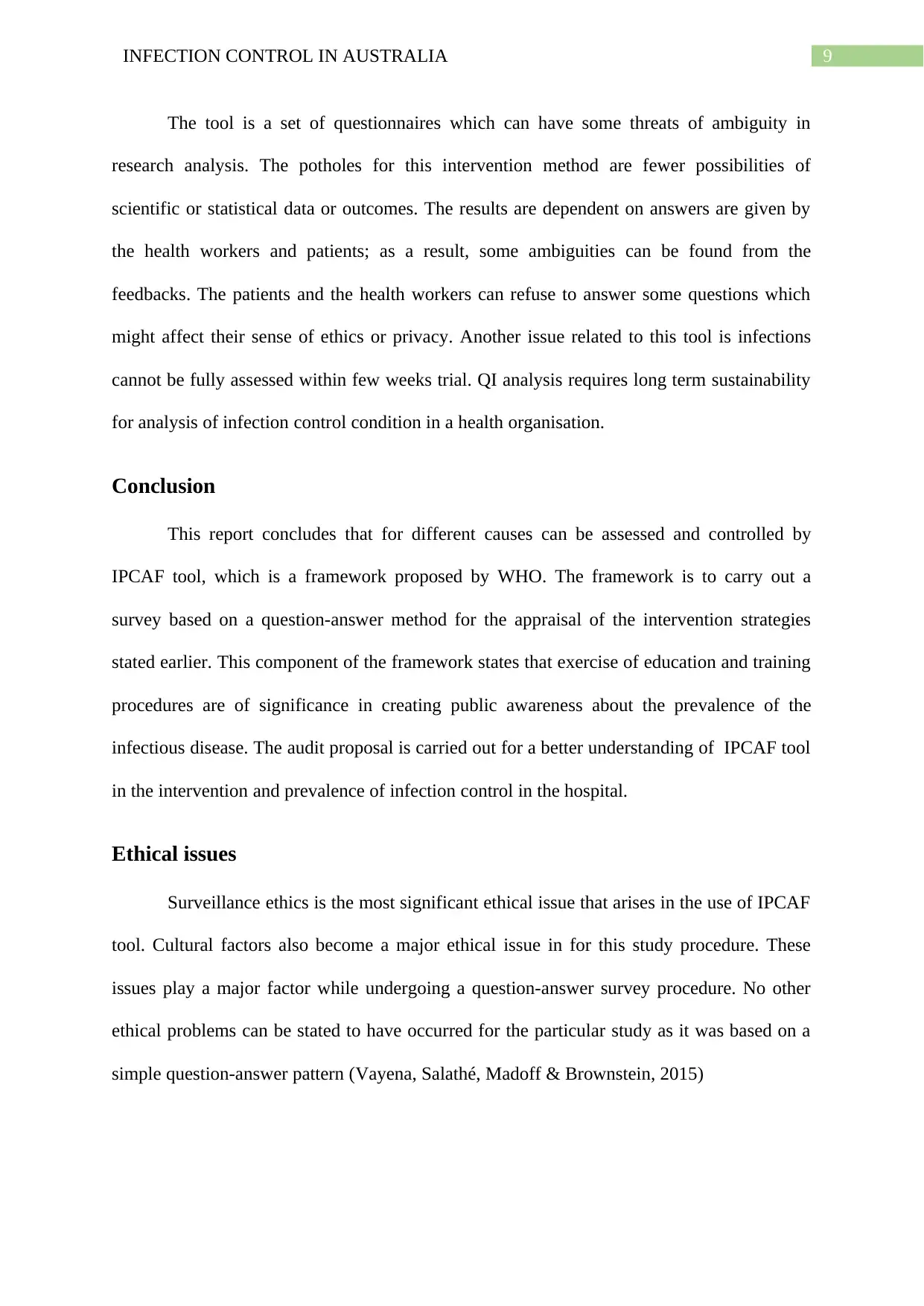
9INFECTION CONTROL IN AUSTRALIA
The tool is a set of questionnaires which can have some threats of ambiguity in
research analysis. The potholes for this intervention method are fewer possibilities of
scientific or statistical data or outcomes. The results are dependent on answers are given by
the health workers and patients; as a result, some ambiguities can be found from the
feedbacks. The patients and the health workers can refuse to answer some questions which
might affect their sense of ethics or privacy. Another issue related to this tool is infections
cannot be fully assessed within few weeks trial. QI analysis requires long term sustainability
for analysis of infection control condition in a health organisation.
Conclusion
This report concludes that for different causes can be assessed and controlled by
IPCAF tool, which is a framework proposed by WHO. The framework is to carry out a
survey based on a question-answer method for the appraisal of the intervention strategies
stated earlier. This component of the framework states that exercise of education and training
procedures are of significance in creating public awareness about the prevalence of the
infectious disease. The audit proposal is carried out for a better understanding of IPCAF tool
in the intervention and prevalence of infection control in the hospital.
Ethical issues
Surveillance ethics is the most significant ethical issue that arises in the use of IPCAF
tool. Cultural factors also become a major ethical issue in for this study procedure. These
issues play a major factor while undergoing a question-answer survey procedure. No other
ethical problems can be stated to have occurred for the particular study as it was based on a
simple question-answer pattern (Vayena, Salathé, Madoff & Brownstein, 2015)
The tool is a set of questionnaires which can have some threats of ambiguity in
research analysis. The potholes for this intervention method are fewer possibilities of
scientific or statistical data or outcomes. The results are dependent on answers are given by
the health workers and patients; as a result, some ambiguities can be found from the
feedbacks. The patients and the health workers can refuse to answer some questions which
might affect their sense of ethics or privacy. Another issue related to this tool is infections
cannot be fully assessed within few weeks trial. QI analysis requires long term sustainability
for analysis of infection control condition in a health organisation.
Conclusion
This report concludes that for different causes can be assessed and controlled by
IPCAF tool, which is a framework proposed by WHO. The framework is to carry out a
survey based on a question-answer method for the appraisal of the intervention strategies
stated earlier. This component of the framework states that exercise of education and training
procedures are of significance in creating public awareness about the prevalence of the
infectious disease. The audit proposal is carried out for a better understanding of IPCAF tool
in the intervention and prevalence of infection control in the hospital.
Ethical issues
Surveillance ethics is the most significant ethical issue that arises in the use of IPCAF
tool. Cultural factors also become a major ethical issue in for this study procedure. These
issues play a major factor while undergoing a question-answer survey procedure. No other
ethical problems can be stated to have occurred for the particular study as it was based on a
simple question-answer pattern (Vayena, Salathé, Madoff & Brownstein, 2015)
Paraphrase This Document
Need a fresh take? Get an instant paraphrase of this document with our AI Paraphraser
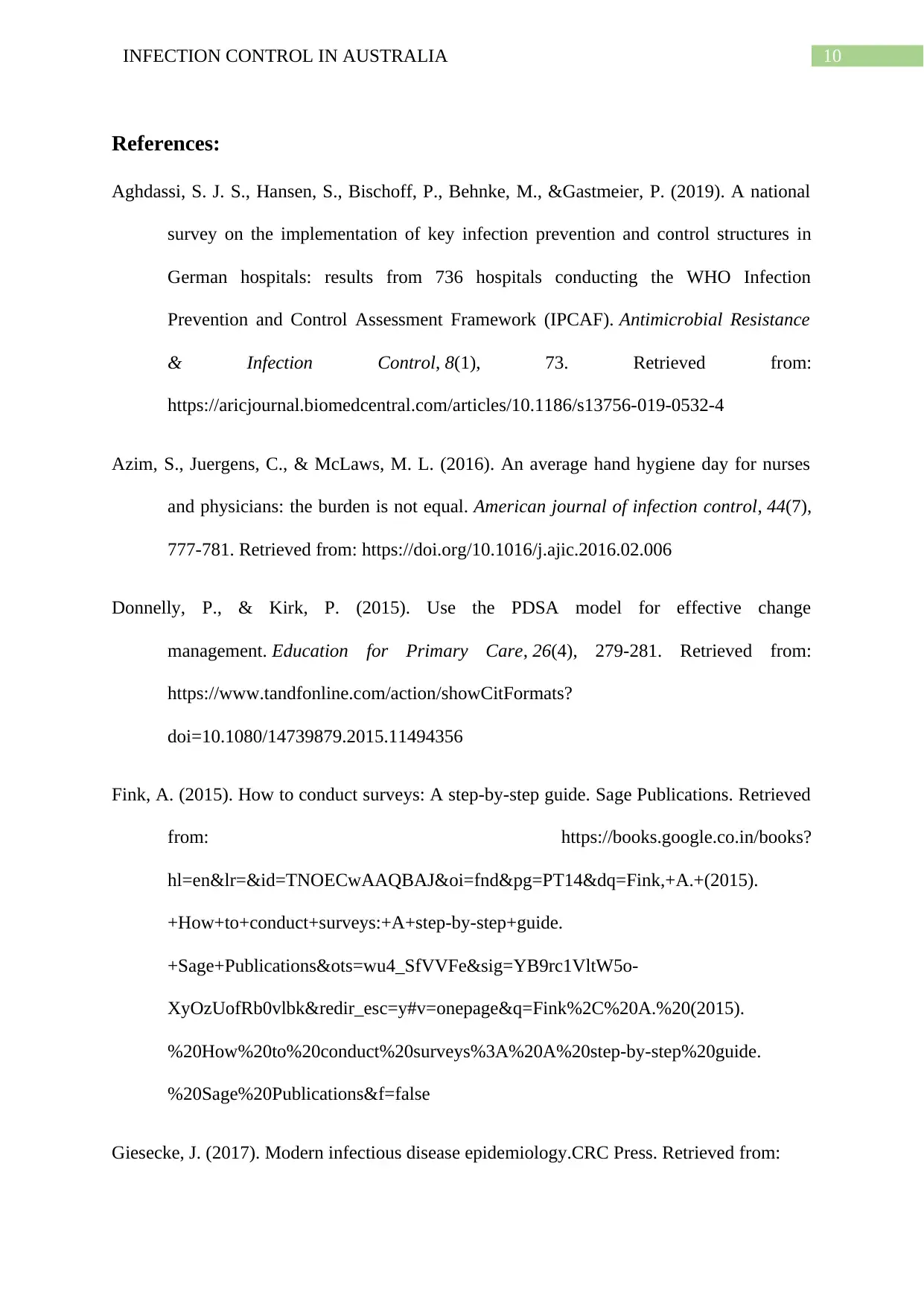
10INFECTION CONTROL IN AUSTRALIA
References:
Aghdassi, S. J. S., Hansen, S., Bischoff, P., Behnke, M., &Gastmeier, P. (2019). A national
survey on the implementation of key infection prevention and control structures in
German hospitals: results from 736 hospitals conducting the WHO Infection
Prevention and Control Assessment Framework (IPCAF). Antimicrobial Resistance
& Infection Control, 8(1), 73. Retrieved from:
https://aricjournal.biomedcentral.com/articles/10.1186/s13756-019-0532-4
Azim, S., Juergens, C., & McLaws, M. L. (2016). An average hand hygiene day for nurses
and physicians: the burden is not equal. American journal of infection control, 44(7),
777-781. Retrieved from: https://doi.org/10.1016/j.ajic.2016.02.006
Donnelly, P., & Kirk, P. (2015). Use the PDSA model for effective change
management. Education for Primary Care, 26(4), 279-281. Retrieved from:
https://www.tandfonline.com/action/showCitFormats?
doi=10.1080/14739879.2015.11494356
Fink, A. (2015). How to conduct surveys: A step-by-step guide. Sage Publications. Retrieved
from: https://books.google.co.in/books?
hl=en&lr=&id=TNOECwAAQBAJ&oi=fnd&pg=PT14&dq=Fink,+A.+(2015).
+How+to+conduct+surveys:+A+step-by-step+guide.
+Sage+Publications&ots=wu4_SfVVFe&sig=YB9rc1VltW5o-
XyOzUofRb0vlbk&redir_esc=y#v=onepage&q=Fink%2C%20A.%20(2015).
%20How%20to%20conduct%20surveys%3A%20A%20step-by-step%20guide.
%20Sage%20Publications&f=false
Giesecke, J. (2017). Modern infectious disease epidemiology.CRC Press. Retrieved from:
References:
Aghdassi, S. J. S., Hansen, S., Bischoff, P., Behnke, M., &Gastmeier, P. (2019). A national
survey on the implementation of key infection prevention and control structures in
German hospitals: results from 736 hospitals conducting the WHO Infection
Prevention and Control Assessment Framework (IPCAF). Antimicrobial Resistance
& Infection Control, 8(1), 73. Retrieved from:
https://aricjournal.biomedcentral.com/articles/10.1186/s13756-019-0532-4
Azim, S., Juergens, C., & McLaws, M. L. (2016). An average hand hygiene day for nurses
and physicians: the burden is not equal. American journal of infection control, 44(7),
777-781. Retrieved from: https://doi.org/10.1016/j.ajic.2016.02.006
Donnelly, P., & Kirk, P. (2015). Use the PDSA model for effective change
management. Education for Primary Care, 26(4), 279-281. Retrieved from:
https://www.tandfonline.com/action/showCitFormats?
doi=10.1080/14739879.2015.11494356
Fink, A. (2015). How to conduct surveys: A step-by-step guide. Sage Publications. Retrieved
from: https://books.google.co.in/books?
hl=en&lr=&id=TNOECwAAQBAJ&oi=fnd&pg=PT14&dq=Fink,+A.+(2015).
+How+to+conduct+surveys:+A+step-by-step+guide.
+Sage+Publications&ots=wu4_SfVVFe&sig=YB9rc1VltW5o-
XyOzUofRb0vlbk&redir_esc=y#v=onepage&q=Fink%2C%20A.%20(2015).
%20How%20to%20conduct%20surveys%3A%20A%20step-by-step%20guide.
%20Sage%20Publications&f=false
Giesecke, J. (2017). Modern infectious disease epidemiology.CRC Press. Retrieved from:
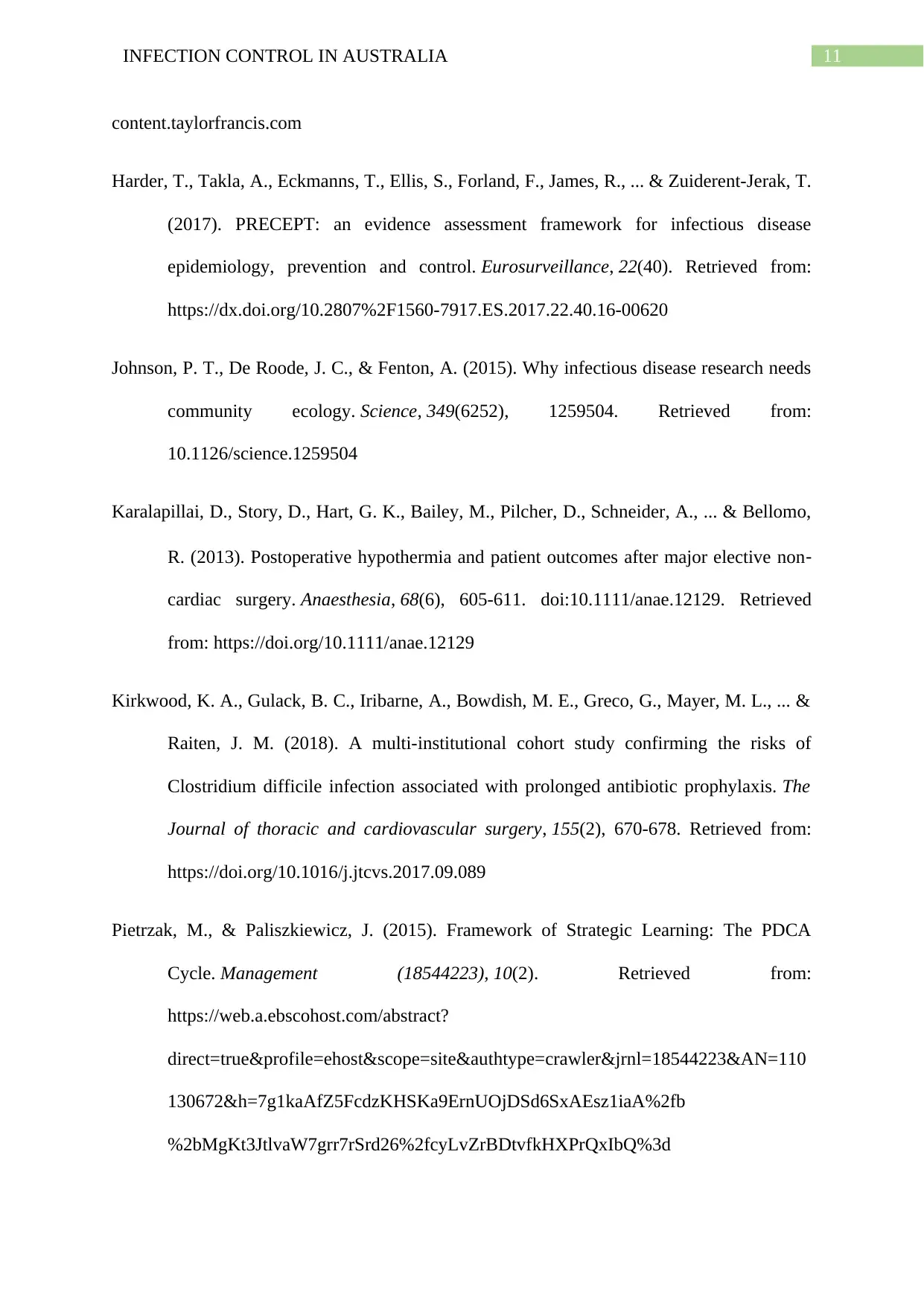
11INFECTION CONTROL IN AUSTRALIA
content.taylorfrancis.com
Harder, T., Takla, A., Eckmanns, T., Ellis, S., Forland, F., James, R., ... & Zuiderent-Jerak, T.
(2017). PRECEPT: an evidence assessment framework for infectious disease
epidemiology, prevention and control. Eurosurveillance, 22(40). Retrieved from:
https://dx.doi.org/10.2807%2F1560-7917.ES.2017.22.40.16-00620
Johnson, P. T., De Roode, J. C., & Fenton, A. (2015). Why infectious disease research needs
community ecology. Science, 349(6252), 1259504. Retrieved from:
10.1126/science.1259504
Karalapillai, D., Story, D., Hart, G. K., Bailey, M., Pilcher, D., Schneider, A., ... & Bellomo,
R. (2013). Postoperative hypothermia and patient outcomes after major elective non‐
cardiac surgery. Anaesthesia, 68(6), 605-611. doi:10.1111/anae.12129. Retrieved
from: https://doi.org/10.1111/anae.12129
Kirkwood, K. A., Gulack, B. C., Iribarne, A., Bowdish, M. E., Greco, G., Mayer, M. L., ... &
Raiten, J. M. (2018). A multi-institutional cohort study confirming the risks of
Clostridium difficile infection associated with prolonged antibiotic prophylaxis. The
Journal of thoracic and cardiovascular surgery, 155(2), 670-678. Retrieved from:
https://doi.org/10.1016/j.jtcvs.2017.09.089
Pietrzak, M., & Paliszkiewicz, J. (2015). Framework of Strategic Learning: The PDCA
Cycle. Management (18544223), 10(2). Retrieved from:
https://web.a.ebscohost.com/abstract?
direct=true&profile=ehost&scope=site&authtype=crawler&jrnl=18544223&AN=110
130672&h=7g1kaAfZ5FcdzKHSKa9ErnUOjDSd6SxAEsz1iaA%2fb
%2bMgKt3JtlvaW7grr7rSrd26%2fcyLvZrBDtvfkHXPrQxIbQ%3d
content.taylorfrancis.com
Harder, T., Takla, A., Eckmanns, T., Ellis, S., Forland, F., James, R., ... & Zuiderent-Jerak, T.
(2017). PRECEPT: an evidence assessment framework for infectious disease
epidemiology, prevention and control. Eurosurveillance, 22(40). Retrieved from:
https://dx.doi.org/10.2807%2F1560-7917.ES.2017.22.40.16-00620
Johnson, P. T., De Roode, J. C., & Fenton, A. (2015). Why infectious disease research needs
community ecology. Science, 349(6252), 1259504. Retrieved from:
10.1126/science.1259504
Karalapillai, D., Story, D., Hart, G. K., Bailey, M., Pilcher, D., Schneider, A., ... & Bellomo,
R. (2013). Postoperative hypothermia and patient outcomes after major elective non‐
cardiac surgery. Anaesthesia, 68(6), 605-611. doi:10.1111/anae.12129. Retrieved
from: https://doi.org/10.1111/anae.12129
Kirkwood, K. A., Gulack, B. C., Iribarne, A., Bowdish, M. E., Greco, G., Mayer, M. L., ... &
Raiten, J. M. (2018). A multi-institutional cohort study confirming the risks of
Clostridium difficile infection associated with prolonged antibiotic prophylaxis. The
Journal of thoracic and cardiovascular surgery, 155(2), 670-678. Retrieved from:
https://doi.org/10.1016/j.jtcvs.2017.09.089
Pietrzak, M., & Paliszkiewicz, J. (2015). Framework of Strategic Learning: The PDCA
Cycle. Management (18544223), 10(2). Retrieved from:
https://web.a.ebscohost.com/abstract?
direct=true&profile=ehost&scope=site&authtype=crawler&jrnl=18544223&AN=110
130672&h=7g1kaAfZ5FcdzKHSKa9ErnUOjDSd6SxAEsz1iaA%2fb
%2bMgKt3JtlvaW7grr7rSrd26%2fcyLvZrBDtvfkHXPrQxIbQ%3d
⊘ This is a preview!⊘
Do you want full access?
Subscribe today to unlock all pages.

Trusted by 1+ million students worldwide
1 out of 17
Related Documents
Your All-in-One AI-Powered Toolkit for Academic Success.
+13062052269
info@desklib.com
Available 24*7 on WhatsApp / Email
![[object Object]](/_next/static/media/star-bottom.7253800d.svg)
Unlock your academic potential
Copyright © 2020–2025 A2Z Services. All Rights Reserved. Developed and managed by ZUCOL.





